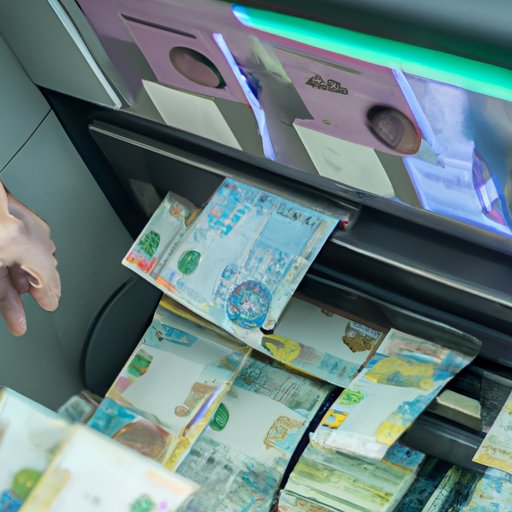
I. Introduction
Have you ever wondered if you can deposit a money order in an ATM? If so, you’re not alone. Many people are not aware that depositing a money order in an ATM is possible. In fact, it’s a quick and easy way to deposit money orders without having to wait in long lines at the bank. In this article, we will provide you with a comprehensive guide on how to deposit a money order in an ATM, as well as tips and tricks to make the process smoother.
II. The Ultimate Guide to Depositing Money Orders in ATMs
Depositing a money order in an ATM is a simple process. First, you need to endorse the money order by signing the back of it. Next, you need to fill out a deposit slip. You can usually find deposit slips in the ATM or at the bank’s website. Finally, insert the money order and deposit slip into the ATM, and it will take care of the rest.
It’s important to note that not all ATMs accept money orders. Before attempting to deposit a money order, make sure the ATM you’re using supports it. You can check the ATM’s specifications online or by contacting your bank.
If the ATM does not accept money orders, you can still deposit them at the bank or through alternative services such as mobile banking or remote deposit capture.
III. How to Deposit a Money Order Without Leaving Your House: Step-by-Step Guide to ATM Deposits
Remote deposit capture is a service that allows you to deposit a money order without leaving your house. To use this service, you need to have a mobile device or computer with internet access, a bank account, and a mobile banking app or website that supports remote deposit capture.
The process of depositing money orders through remote deposit capture is similar to depositing them in ATMs. First, you need to endorse the money order and fill out a deposit slip. Then, you need to take a photo of the front and back of the money order and upload it to the mobile banking app or website. Finally, confirm the deposit amount and submit the transaction.
It’s important to keep the original money order in a safe place until the deposit is cleared. Usually, money orders take a few business days to clear, depending on the bank’s policies.
IV. Everything You Need to Know About Depositing Money Orders in ATMs
Depositing money orders in ATMs has many benefits, including convenience, speed, and accessibility. However, there are also potential risks and challenges involved, such as ATM malfunctions, deposit errors, and fraud.
To mitigate these risks and overcome these challenges, you need to follow some best practices. These include checking the ATM’s specifications before attempting to deposit a money order, keeping track of your receipts, reviewing your account balance regularly, and reporting any suspicious activity to your bank immediately.
V. 5 Simple Steps to Deposit Your Money Order at an ATM Near You
If you’re unsure of how to deposit a money order in an ATM, follow these simple steps:
- Endorse the money order by signing the back of it.
- Fill out a deposit slip.
- Insert the money order and deposit slip into the ATM.
- Verify the deposit amount and confirm the transaction.
- Wait for the ATM to process the transaction and print a receipt.
Remember to keep the receipt as proof of your transaction.
VI. The Dos and Don’ts of Depositing Money Orders at ATMs
When depositing money orders in ATMs, there are some things you should do and some things you should avoid doing. Here are some dos and don’ts:
- Do check the ATM’s specifications before attempting to deposit a money order.
- Do endorse the money order and fill out a deposit slip.
- Do keep track of your receipts and review your account balance regularly.
- Don’t deposit money orders that are older than six months or have already been cashed.
- Don’t deposit money orders that exceed the ATM’s deposit limit.
- Don’t deposit money orders that are not made out to you or have altered information.
VII. Maximizing Convenience: Depositing Your Money Order at the Nearest ATM
To maximize convenience and optimize location selection, you need to find and locate the nearest ATM to deposit your money order. You can do this by using your bank’s mobile app or website, or by using online directories such as ATM Locator or Mastercard ATM Locator.
Before heading to the ATM, make sure you have all the necessary documents and information, such as your bank account number, deposit slip, and endorsed money order. You should also make sure the ATM is working properly and there are no security concerns in the area.
VIII. Quick and Easy Guide to Depositing Your Money Order at Your Bank’s ATM
If you prefer to deposit your money order at your bank’s ATM, follow these quick and easy steps:
- Locate your bank’s ATM and insert your debit card.
- Enter your PIN and select “Deposit” on the main menu.
- Select “Money Order” as the deposit type.
- Enter the deposit amount and verify it.
- Insert the endorsed money order and deposit slip into the ATM.
- Verify the deposit information and confirm the transaction.
- Wait for the ATM to process the transaction and print a receipt.
IX. Conclusion
In conclusion, depositing a money order in an ATM is a quick, easy, and convenient way to deposit money orders. By following the steps and guidelines provided in this article, you can confidently deposit your money order in an ATM without any issues or complications.
Remember to always check the ATM’s specifications, endorse the money order, and keep track of your receipts and account balance. By doing so, you can avoid potential risks and challenges and enjoy the benefits of depositing money orders in ATMs.
So go ahead and give it a try.




